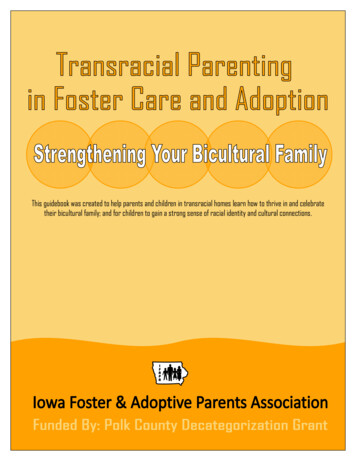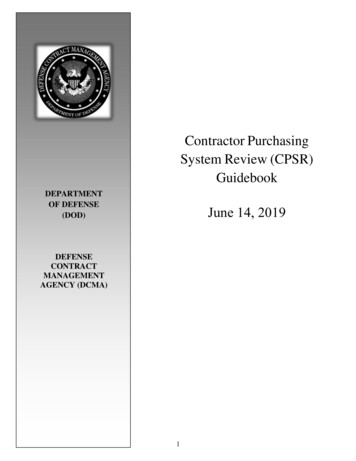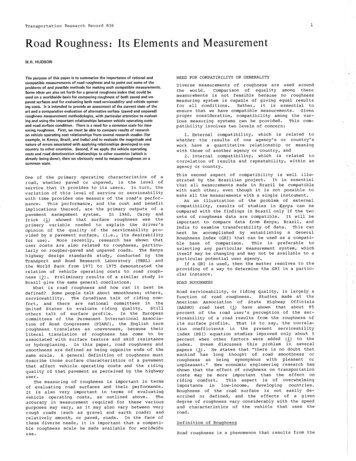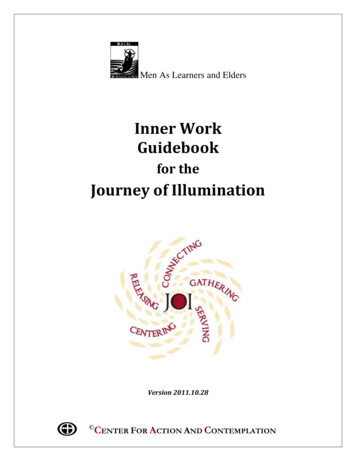
Transcription
Transracial Parenting in Foster Care & Adoption - Strengthening Your Bicultural FamilyThis guidebook was created to help parents and children in transracial homes learn how to thrive in and celebratetheir bicultural family; and for children to gain a strong sense of racial identity and cultural connections.1
Transracial Parenting in Foster Care & Adoption - Strengthening Your Bicultural Family2
Transracial Parenting in Foster Care & Adoption - Strengthening Your Bicultural FamilyTable of Contents:Page #INTRODUCTION4A TRANSRACIALLY-ADOPTED CHILD’S BILL OF RIGHTS5TRANSRACIAL PARENTING PLEDGE6WHAT DOES IT MEAN TO BE A TRANSRACIAL FAMILY?7HOW FAR HAVE WE COME? THE HISTORY OF TRANSRACIAL FAMILIES8 - 10GENERAL PARENTING TASKS FOR TRANSRACIAL PARENTS11 - 14HOW TO CONNECT YOUR CHILD TO THEIR CULTURE AND HOW TO BECOME A BICULTURAL FAMILY15 - 16THE VOICES OF ADULT TRANSRACIAL ADOPTEES17 - 24RACISM AND DISCRIMINATION – FOSTERING RACIAL COPING SKILLS25 - 28ANSWERING TOUGH QUESTIONS28 - 29SKIN CARE & HAIR CARE30 - 32RESOURCES33 - 46General Transracial ResourcesOnline Help, Books, Videos, Toys & DollsOrganizations & Internet ResourcesCultural CampsAfrican American ResourcesAsian American ResourcesNative American ResourcesHispanic ResourcesEuropean American ResourcesArab American ResourcesLanguage & Self-assessment tools3
Transracial Parenting in Foster Care & Adoption - Strengthening Your Bicultural FamilyINTRODUCTIONAccording to transracial adoption expert Joseph Crumbley, all foster children, whether in atransracial placement or not, worry “Will I be accepted in this home, even if I am from adifferent (biological) family?”Children in transracial homes also worry “Will I be accepted even if I’m from a differentrace?”This booklet will help you understand the importance of race and culture for your family; and sharehelpful hints, parenting tips and resources for you on the culturally rich journey of transracialparenting. Building your child’s sense of racial identity, connecting your child to his or her culture andrace, and preparing your child to deal with discrimination are important and often intimidatingparenting tasks. It is okay to be uncomfortable. Knowledge is key to helping you navigate the path oftransracial parenting effectively. Ask questions, seek information, and forge through the discomfortand anxiety. This is an exciting and eye-opening journey, full of ups and downs, full of laughter, and fullof heart-warming experiences. Parenting a child of another race and creating a bicultural homeenvironment will be the foundation for success in your family.As a transracial parent, have you ever asked yourself the following questions?Am I doing enough to help my black child feel a sense of belonging in our family?How can I better connect my Latino child to his culture, his racial roots?How can I prepare my daughter for the impending discrimination she will experience because she isblack? How can I prepare my family to experience racism now that we are a transracial family? What do I need to do to meet my Korean child’s needs around race and culture? How can I advocate for multicultural educational materials in the schools? Or, have you ever been too embarrassed to ask questions about culture, afraid of saying the wrongthing or embarrassed about not knowing the answer?To understand the “how-to’s” of parenting transracially, it is necessary to visit the past and understandthe historical foundation of race and white privilege in society. Though racism today is not usually asovert as it was in decades past, it is still very present on a more subtle and institutionalized level. Tobest help your children develop a healthy racial identity, it is necessary to educate yourself aboutracism yesterday and racism today. For more information on any topic in this manual, we haveincluded an extensive resource section in the back of this book.4
Transracial Parenting in Foster Care & Adoption - Strengthening Your Bicultural FamilyA Transracially-Adopted Child's Bill of RightsAdapted by Liza Steinberg Triggs from "A Bill of Rights for Mixed Folks," by Marilyn Dramé Every child is entitled to love and full membership in her family. Every child is entitled to have his culture embraced and valued. Every child is entitled to parents who know that this is a race conscious society. Every child is entitled to parents who know that she will experience life differently than they do. Every child is entitled to parents who are not looking to "save" him or to improve the world. Every child is entitled to parents who know that being in a family doesn't depend on "matching." Every child is entitled to parents who know that transracial adoption changes the family forever. Every child is entitled to be accepted by extended family members. Every child is entitled to parents who know that, if they are white, they benefit from racism. Every child is entitled to parents who know that they can't transmit the child's birth culture if it isnot their own. Every child is entitled to have items at home that are made for and by people of his race. Every child is entitled to opportunities to make friends with people of her race or ethnicity. Every child is entitled to daily opportunities of positive experiences with his birth culture. Every child is entitled to build racial pride within her own home, school, and neighborhood. Every child is entitled to have many opportunities to connect with adults of the child's race. Every child is entitled to parents who accept, understand and empathize with her culture. Every child is entitled to learn survival, problem-solving, and coping skills in a context of racialpride. Every child is entitled to take pride in the development of a dual identity and a multicultural/multiracial perspective on life. Every child is entitled to find his multiculturalism to be an asset and to conclude, "I've got thebest of both worlds."Copyright 1998-2008 by Pact, An Adoption 5
Transracial Parenting in Foster Care & Adoption - Strengthening Your Bicultural FamilyTransracial Parenting PledgeAs one committed to parenting cross-culturally, transracially, and or internationally,I pledge the following:1) To recognize the added value that diversity brings to my life, even outside of my children2) To create a diverse home environment and family life that is reflective of our multicultural family3) To prepare my child with survival skills to successfully navigate a race conscious society4) To help my child to develop pride in his or her racial, ethnic identity and group membership5) To confront racial, ethnic and cultural intolerance within my family, friends, and community6) To seek and develop friendships that reflect my commitment to multiculturalism7) To engage multicultural communities in order to learn, grow and share8) To learn what matters to the racial/ethnic group of my child and why9) To see ourselves as a multiracial family, a family of color and to embrace what that means intoday’s and tomorrows society10) To move beyond the limits of my comfort, knowledge, and biases (to a place of culturalcompetence and responsiveness within my family and community through words and action)11) To not ascribe to the notion of color blindness, but to color appreciation12) To recognize that love is not enough, that it is necessary, but not sufficient in and of itselfParent’s SignatureDateParent’s SignatureDateCopyright 2007 by Robert O’Connorwww.transracialadoptiontraining.com6
Transracial Parenting in Foster Care & Adoption - Strengthening Your Bicultural FamilyWHAT DOES IT MEAN TO BE A TRANSRACIAL FAMILY?How are transracial foster and adoptive families defined?Transracial foster and adoptive families consist of children of one race or culture being raised byparents of a different race or culture. Transracial families are considered families of color.How is “culture” defined?Culture is defined in many different ways; however, most definitions contain the following elements:shared language, race, customs, beliefs, values, social status, religious beliefs, gender, sexualorientation, and others. Given this broad definition, every person is a part of several different cultures.Interacting with people from a different culture than one’s own can create discomfort and anxiety.Interacting with people of one’s own culture brings comfort and a sense of belonging.What do these definitions mean when it comes to parenting children of other cultures and races?White parents of children of color have the responsibility to help their children define themselves as amember of their own genetic racial community. Whether of a single race or a mixed race, (biracial),children either feel “a part of” or “separate from.” Without connection to their own roots, a blackchild being raised in a white world will feel “separate from” the white people surrounding him wholook different than him. He will also feel “separate from” the black people he looks like, who have thesame cultural background, but he has no connection to. He needs connection to those that haveshared culture and race. This is vital to his healthy development. No matter how he is raised, societywill assign him to the race and culture of being black, and without connection, he will feel lost andisolated, not fitting in with the white culture he was raised in and not fitting in with his own racialculture. By connecting your children to their own race and culture, they will learn to grow in theirroots while incorporating what they are learning from you about their identity in a transracial home.They become bicultural, bridging the gap between the two worlds.Knowing this, it is important to evaluate your own beliefs about other cultures and other races beforeparenting transracially. Every person has biases, and uncovering them is a lesson in self-awareness andan opportunity for personal growth.Here are questions to ask yourself before deciding to parent transracially: How many friends do you have of another race or culture? What types of things do you seek to know about other cultures? Do you attend multi-cultural events and celebrations? What do you know about specialized skin and hair care for children of color? Have you incorporated other races and cultures into your home life? Are the schools in your area diverse with children of many cultures? What cultures are represented in your church? How do your extended family members view people of different races?7
Transracial Parenting in Foster Care & Adoption - Strengthening Your Bicultural FamilyHOW FAR HAVE WE COME?The History of Transracial Foster Care and AdoptionIn the mid 1950’s, the Child Welfare League of America reported that African American children werethe largest group of children in need of adoptive homes. Public and private agencies stepped up effortsto place these children by opting to include more kin, single female and foster parents in the pool ofprospective adoptive parents. The next alternative for adoptive placement was to cross racial lines andtransracially place children.At the time, racial matching became one of many matching criteria that was considered to be goodsocial work practice and in the best interest of the children. Children and families were matched onphysical characteristics, including skin color, as well as social status and religious preference. Whilemost of these other matching criteria were abandoned in the 1970’s and 1980’s in favor of matchingcriteria that focused on the ability of families to parent children with specific needs, racial matchingwas still an often used criteria of workers. The field was divided and the National Association of BlackSocial Workers voiced concern about children in transracial placements being at risk for racial identityissues and a disconnect from their cultural roots.Because many black children lingered in care too long while waiting for a black foster or adoptivehome, the Multiethnic Placement Act (MEPA) of 1994 was signed into law. MEPA prohibits denying ordelaying placement of a child based on the race, color or national origin of the child or of the foster/adoptive parent. MEPA was enacted to decrease the length of time that children waited to be placed inhomes; to focus on recruitment and retention of foster parents who can meet the unique needs ofchildren waiting to be placed; and to eliminate discrimination based on race, color or national origin.However, this version of MEPA contained a stipulation that racial and ethnic background could still beconsidered in making a placement. The Interethnic Adoption Provisions Act (also known as MEPA II)was then passed in 1996. This version amended the language of the original MEPA to prohibitdiscrimination on the basis of race in placement. Race was now to be excluded from placementguidelines. Under MEPA II, race may only enter into the placement decision when race issues are amatter of the best interest for the particular child in question.Transracial Foster Care and Adoption TodayCurrently there is a disproportionate number of African American children in foster care. In the generalpopulation, African American children represent 15% of all children. In foster care, African Americanchildren represent 32% of the 510,000 children. In addition to these findings, African American andNative American children have lower rates of adoption than other races (U.S. DHHS, 2008a; U.S. GAO,2007).In May 2008, the Evan B. Donaldson Adoption Institute released findings on Families for AfricanAmerican Children: The Role of Race & Law in Adoption from Foster Care to address these disparities.The recommendations of this report are supported by the North American Council on AdoptableChildren, the Child Welfare League of America, the Dave Thomas Foundation for Adoption, theAdoption Exchange Association, the National Association of Black Social Workers, Voice for Adoption,the Foster Care Alumni of America and the National Association for Social Workers.8
Transracial Parenting in Foster Care & Adoption - Strengthening Your Bicultural FamilyThis report details the results of 35 years of research on transracial adoption, concluding the following3 key issues:1. Transracial adoption in itself does not produce psychological or social maladjustmentproblems in children.2. Transracially adopted children and their families face a range of challenges, and themanner in which parents handle them facilitates or hinders children’s development.3. Children in foster care come to adoption with many risk factors that pose challenges forhealthy development. For these children, research points to the importance of adoptiveplacements with families who can address their individual issues and maximize theiropportunity to develop to their fullest potential.Though there is limited research on the topic of transracially adopted children, recent findingsreported by the Evan B. Donaldson Institute have detailed the following issues common to children intransracial homes:1.2.3.Transracially adopted children face challenges in coping with being “different.”Transracially adopted children may struggle to develop a positive racial/ethnic identity.A key life skill for transracially adopted children is the ability to cope with discrimination.To summarize the conclusions of recommendations made by the Evan B. DonaldsonInstitute, it is recommended that children of color are placed with families who can meettheir long-term needs, through supporting connection of the child to his or her own culture,fostering a healthy and positive racial identity, and preparing the child to deal withdiscrimination.To read the entire report by the Evan B. Donaldson Institute, log onto:www.adoptioninstitute.org/research/2008 05 mepa.phpWhat is “white privilege” and what does it mean in transracial foster care and adoption?What is white privilege? It is being in the majority group in society, having power, and benefiting as aresult. Think of a time when you were not in the majority group and you will quickly understand howdifficult it is to be a minority in any group. Being the only female in a male group, or vice versa. Being the only overweight person in a group of non-overweight people. Being the only foster parent in a group of social workers. Being the only married person in a group of single people.9
Transracial Parenting in Foster Care & Adoption - Strengthening Your Bicultural FamilyPeggy McIntosh, Associate Director of the Wellesley College Center for Research on Women, said thatwhite privilege is “like an invisible weightless knapsack of special provisions, maps, passports, codebooks, visas, clothes, tools, and blank checks.” McIntosh has written several articles on the issue alongwith the book “White Privilege: Unpacking the Invisible Knapsack” that address this culturalphenomenon.Some of the items on McIntosh’s White Privilege Checklist include: “I can arrange to be in the company of people of my race most of the time.” “I can go shopping alone most of the time, pretty well assured that I will not be followed orharassed.” “I can turn on the television or open to the front page of the paper and see people of my racewidely represented.” “I am never asked to speak for all of the people of my racial group.” “I can take a job or enroll in a college with an affirmative action policy without having my coworkers or peers assume I got it because of my race.” “I can easily buy posters, postcards, picture books, greeting cards, dolls, toys, and children’smagazines featuring people of my race.” “I can walk into a classroom and know I will not be the only member of my race.”These are only a few of the items on McIntosh’s White Privilege Checklist. These items are a steppingoff point for discussion and for discovering more about how white privilege impacts all families,including transracial families.White parents of minority children must educate themselves about white privilege to betterunderstand their children’s experience in the world, to help their children navigate a world of being inthe minority group, and to begin advocating on behalf of equality for their children.When minority children are surrounded by people of their own culture, it is usually a needed “break”from being stared at for being different, from feeling like they don’t belong because of their race, fromwondering who is and isn’t making assumptions about them for their race, from being watched bystore security, and from being lumped together into one broad and inaccurate stereotype. Surroundedby people of their own culture, children will feel a sense of belonging and a freedom to be themselvesnot otherwise felt in the majority culture. This “break” is what children need on a regular basis.To further understand how a person of a minority race feels in this society of white privilege, challengeyourself to go somewhere where you are in the minority race. Suddenly you are thinking about thingsthat normally you might take for granted.Imagine walking down the sidewalk as a white person in apredominantly black community. How do you think you wouldfeel? Would you feel like you fit in? Would you be acutely awareof the fact that you are the only white person in the area .are youfeeling alone? Would you know how to “fit in” if you lived here?Would you need to talk differently to fit in? Or dress differently?Would you be in danger of being attacked for not looking like mostof the people here or for being different? Would you be treatedthe same way in the neighborhood stores, or cautiously watchedbecause of your different-ness? Where would you feel like you fitin? What would you want to know if you were transplanted to thisneighborhood to live long-term? And how would you find out?10
Transracial Parenting in Foster Care & Adoption - Strengthening Your Bicultural FamilyGENERAL PARENTING TASKS FOR TRANSRACIAL PARENTS:One of the most common things parents and professionals hear from transracial adoptees is thatthey want friends or brothers and sisters that look like them (eyes, skin color, etc.).Children living in transracial homes need parents who recognize their need to know their cultural roots.Experts recommend that parents do the following things to meet the cultural needs of their children :1. Interact with people of your child’s race – form friendships with peopleof all cultures, valuing diversity.2. Live in a diverse, integrated neighborhood.3. Recognize multiculturalism is an asset and valued.4. Seek out mentors within your child’s culture - for yourself and for yourchild.5. Choose integrated schools that offer unbiased educational materials.6. Stand up to racism and discrimination. Have a no tolerance policy for it.7. Provide the appropriate hair and skin care for your child.8. Make your home a bicultural home.9. Talk about race and culture often.10. Go to places where your child is surrounded by people of his/her samerace and culture.The Culture of Children in Foster Care and AdoptionTrauma, Grief, and AttachmentBefore looking at the above parenting tasks, it is important to recognize the culture of children in carethat impacts their growth and well-being. Because children in foster and adoptive homes often have abackground of abuse and neglect, along with separation from their parents, it is necessary to brieflyoutline how the many layers of trauma and grief impact a child’s sense of identity, belonging andgeneral well-being. When children experience trauma through abuse, neglect, and/or separation frombirth parents, they must deal with trauma and grief. Your first task is to provide them with a safeenvironment to heal.If there are attachment issues present, as there often are with children in foster and adoptive homes,it is important to seek out the professional help of an attachment-trained therapist. Without healthyattachment, the traumatized brains of these children will stay stuck in a flight or fight response,experiencing parental nurturing from you as pain and sometimes terror. Intimacy hurts for childrenwith attachment issues. Specialized parenting techniques are necessary to help them heal.11
Transracial Parenting in Foster Care & Adoption - Strengthening Your Bicultural FamilyAgain, a trained therapist can assist in this process. In general, the earlier the intervention occurs on adeveloping brain, the better the results.In addition to the issues of attachment, trauma, grief and loss, children in transracial homes experiencean additional layer of struggle to find their racial identity in a home that doesn’t represent their ownrace. Building a child’s racial identity is an important task for parents in transracial homes.Self-Esteem and Positive Racial IdentityRobert O’Connor, adult transracial adoptee, therapist and trainer has said, “if you are the only one, youare alone.” If you are the only one who doesn’t look like the others, you are alone. Feeling differentfrom others can create low self-esteem, especially if a child views “different” as “bad”.What is Self-Esteem?Self-esteem is a person’s feeling of self-worth or a feeling of being of value - in their family, in theircircle of friends, in the world.High self-esteem creates a foundation to go out into the world with confidence and resiliency; with awillingness to take necessary risks and persevere through challenges. Self-esteem is built throughrepeated small successes, through a sense of belonging and feeling safe at home, and through beingvalued within the family and in broader society.Low self-esteem robs a person of the courage to step out into the world with confidence. A child withlow self-esteem might struggle with the ability to take necessary risks or form new relationships, or goafter a dream. Low self-esteem also sets a child up to lack resilience to stress and can set him or her upto be vulnerable to others. This can play itself out in situations of peer pressure, or an inability todefend oneself against bullies or perpetrators, or many other possible scenarios. People with low selfesteem don’t always have the ability to stay in touch with who they are on the inside, and instead theyare susceptible to yield to what is around them – including unhealthy people or circumstances.Additionally, when a person suffers from low self-esteem, it can be very difficult to try new things,work toward goals, persevere through challenges, or learn new skills. They have an intense fear offailure, and a generalized belief that they ARE a failure as a person. The good news is that self-esteemcan be taught.How to Build Self-EsteemCreate a sense of safety for your child – physical and emotional safety. Children need a safe place tolive, free of abuse, and a safe place to talk about their thoughts and feelings - ALL of their thoughts andfeelings. This creates a sense of being valued, a belief that he or she has the right to exist, to think, andto feel; and the knowledge that he or she is important.Create a sense of belonging. Children need to feel a sense of belonging in their families.Acknowledging similarities helps children feel like they belong. It is also important to acknowledge andcelebrate differences as well. Let children’s voices be heard and respected, so that they feel valued inthe context of family.12
Transracial Parenting in Foster Care & Adoption - Strengthening Your Bicultural FamilyPoint out your child’s strengths and abilities often. As they learn new skills in a certain subject (howto multiply or divide; how to solve complicated word problems; how to play a musical instrument; howto shoot a basketball ), acknowledge these small successes. Small successes provide the foundationfor building self-esteem in children.There are many resources for parents on how to build self-esteem in children. Check out your locallibrary, book store, or Internet for resources on this topic.What is racial identity? How can parents instill it?“Positive racial identity depends on our ability to identify fully with our ethnic roots, yetremain confident that race or ethnicity does not limit our opportunities in life.”In addition to understanding what it means to be in foster care or to be adopted, children in transracialhomes need to know what it means to be a member of their own minority group. Having positiveexperiences within their own cultures creates a strong racial identity and sense of belonging, alongwith a resiliency against negative stereotypes that are portrayed in the media and that are experiencedin society through racism and discrimination.Children in transracial homes will also need to learn what it means to be a member of a minority groupwhile living in a family of the majority culture. These children have the additional challenge of learninghow to live “bi-culturally,” walking in two worlds; the world of their own culture and the world of theculture they are living in. Parents who make it a priority to become a bicultural home will help theirchildren develop a strong sense of racial identity and self-esteem. There are many suggestions forhelping children connect to their own cultures on pages 14-15, to provide a great foundation of successfor your child.A child’s self-esteem and racial identity are strengthened when his or her cultural differences arevalued. Examples of this would include providing for the unique skin and hair care of your child, alongwith their dietary and health care needs.In general, it is important to celebrate similarities and differences.Sharing similarities creates bonding and a feeling of belonging.“Your favorite food is spaghetti, just like mine.”“You like to learn about insects, just like your brother.”“You are good at math, just like your father.”Celebrating differences acknowledges that a child is valued because of their uniqueness and thathaving differences is positive.“Yes, your skin is darker than mine. God makes people with all kinds of beautifulskin colors.”“Your hair only needs to be washed once each week; your sister’s hair needs tobe washed every day. You both have beautiful and different hair.”13
Transracial Parenting in Foster Care & Adoption - Strengthening Your Bicultural FamilyIn general, children in transracial placements need to: Live in a home that provides positive experiences with the children’s culture. Remain connected to same-race relationships, with peers and mentors. Live in a home that allows them to feel racial and ethnic pride; and provides thechildren with survival skills. Have parents who allow the children to explore their culture in many different ways;and who recognize the differences between the children’s birth families’ culture andtheir own family culture. Have parents who recognize and understand what the children will experience in arace-conscious society. Have parents who can care for the children’s skin and hair care needs, along withdietary and medical needs. Have the right to feel a belonging to their current family culture as well as to theirculture of origin.Considerations for biracial children:“People of mixed heritage do not have half the experience of being one race and half the experience ofthe other, any more than children of a mother and a father have half the experience of being theirmother’s child and half the experience of being their father’s. They are the product of both, always,whether both are present or not,” from Steinberg and Hall, 1998, “Is Transracial Adoption Easier forMultiracial Kids?” from www.pactadopt.org.White parents may inadvertently believe their biracial child identifies more with their white culture,since the child is half-white and being raised by white parents. The truth is actually the opposite. Mostbiracial children identify themselves as children of color. Society places them in this category as well,since a person’s appearance is what sets him or her apart from others. They can’t choose to be onehalf of who they are. It is important to explore all aspects of a child’s racial roots so t
SKIN CARE & HAIR CARE 30 - 32 RESOURCES 33 - 46 General Transracial Resources Online Help, Books, Videos, Toys & Dolls Organizations & Internet Resources Cultural Camps African American Resources Asian American Resources Native American











